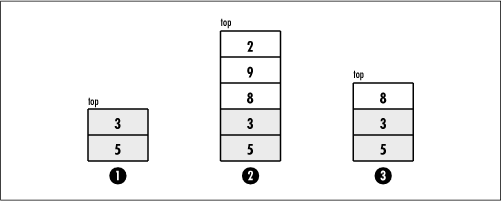Description of Stacks
The distinguishing characteristic of a stack is that it stores and retrieves data in a last-in, first-out, or LIFO, manner. This means that the last element placed on the stack is the first to be removed. A convenient way to think of a stack is as a can of tennis balls. As we place balls in the can, the can is filled up from the bottom to the top. When we remove the balls, the can is emptied from the top to the bottom. Furthermore, if we want a ball from the bottom of the can, we must remove each of the balls above it. In computing, to place an element on the top of a stack, we push it ; to remove an element from the top, we pop it (see Figure 6.1). Sometimes it is useful to inspect the element at the top of a stack without actually removing it, in which case we peek at it.

Get Mastering Algorithms with C now with the O’Reilly learning platform.
O’Reilly members experience books, live events, courses curated by job role, and more from O’Reilly and nearly 200 top publishers.

